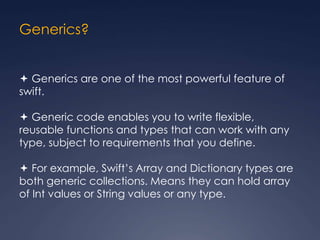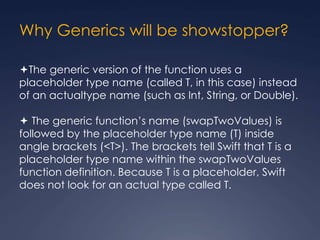Swift Generics
- 2. Generics? ïŠ Generics are one of the most powerful feature of swift. ïŠ Generic code enables you to write flexible, reusable functions and types that can work with any type, subject to requirements that you define. ïŠ For example, Swiftâs Array and Dictionary types are both generic collections. Means they can hold array of Int values or String values or any type.
- 3. Type Parameters ïŠThe placeholder type T is an example of a type parameter. ïŠType parameters specify and name a placeholder type, and are written immediately after the functionâs name, between a pair of matching angle brackets (such as <T>). ïŠYou can provide more than one type parameter by writing multiple type parameter names within the angle brackets, separated by commas.
- 4. Why Generics will be showstopper? ïŠThe generic version of the function uses a placeholder type name (called T, in this case) instead of an actualtype name (such as Int, String, or Double). ïŠ The generic functionâs name (swapTwoValues) is followed by the placeholder type name (T) inside angle brackets (<T>). The brackets tell Swift that T is a placeholder type name within the swapTwoValues function definition. Because T is a placeholder, Swift does not look for an actual type called T.
- 5. Type Parameters ïŠ The generic version of the function uses a placeholder type name (called T, in this case) instead of an actualtype name (such as Int, String, or Double). ïŠ The generic functionâs name (swapTwoValues) is followed by the placeholder type name (T) inside angle brackets (<T>). The brackets tell Swift that T is a placeholder type name within the swapTwoValues function definition. Because T is a placeholder, Swift does not look for an actual type called T. ïŠYou can provide more than one type parameter by writing multiple type parameter names within the angle brackets, separated by commas.
- 6. Naming of Type Parameters ïŠIt is traditional to use the single-character name T for the type parameter. However, you can use any valid identifier as the type parameter name. ïŠIf you are defining more complex generic functions, or generic types with multiple parameters, it is useful to provide more descriptive type parameter names. For example, Swiftâs Dictionary type has two type parametersâone for its keys and one for its values. ïŠAlways give type parameters UpperCamelCase names (such as T and Key) to indicate that they are a placeholder for a type, not a value.
- 7. Generic Types ïŠIn addition to generic functions, Swift enables you to define your own generic types. These are custom classes, structures, and enumerations that can work with any type, in a similar way to Array and Dictionary. ïŠBelow is example of âhow to write generic collection type called Stackâ. struct Stack<T> { var items = [T]() mutating func push(item: T) { //mutating, because they need to modify (or mutate) the structureâs items array items.append(item) } mutating func pop() -> T { return items.removeLast() } }
- 8. Extending a Generic Type ïŠWhen you extend a generic type, the type parameter list from the original type definition is available within the body of the extension, and the original type parameter names are used to refer to the type parameters from the original definition. ïŠFor example: extension Stack { // extends the generic Stack type to add a read-only computed property called topItem var topItem: T? { return items.isEmpty ? nil : items[items.count - 1] } }
- 9. Type Constraints ïŠIt is sometimes useful to enforce certain type constraints on the types that can be used with generic functions and generic types. ïŠType constraints specify that a type parameter must inherit from a specific class, or conform to a particular protocol or protocol composition. ïŠThe basic syntax for type constraints on a generic function is shown below (although the syntax is the same for generic types): func someFunction<T: SomeClass, U: SomeProtocol>(someT: T, someU: U) { // function body goes here }
- 10. Associated Types ïŠAn associated type gives a placeholder name (or alias) to a type that is used as part of the protocol. ïŠThe actual type to use for that associated type is not specified until the protocol is adopted. ïŠAssociated types are specified with the âtypealiasâ keyword. ïŠWhere Clauses: A where clause enables you to require that an associated type conforms to a certain protocol, and/or that certain type parameters and associated types be the same. ïŠYou write a where clause by placing the where keyword immediately after the list of type parameters, followed by one or more constraints for associated types, and/or one or more equality relationships between types and associated types.
- 11. ï END ï







![Generic Types
ïŠIn addition to generic functions, Swift enables you to
define your own generic types. These are custom
classes, structures, and enumerations that can work
with any type, in a similar way to Array and Dictionary.
ïŠBelow is example of âhow to write generic
collection type called Stackâ.
struct Stack<T> {
var items = [T]()
mutating func push(item: T) { //mutating, because
they need to modify (or mutate) the structureâs items
array
items.append(item)
}
mutating func pop() -> T { return items.removeLast()
}
}](https://image.slidesharecdn.com/generics-150207124134-conversion-gate01/85/Swift-Generics-7-320.jpg)
![Extending a Generic Type
ïŠWhen you extend a generic type, the type
parameter list from the original type definition is
available within the body of the extension, and the
original type parameter names are used to refer to
the type parameters from the original definition.
ïŠFor example:
extension Stack { // extends the generic Stack type to
add a read-only computed property called topItem
var topItem: T? {
return items.isEmpty ? nil : items[items.count - 1]
}
}](https://image.slidesharecdn.com/generics-150207124134-conversion-gate01/85/Swift-Generics-8-320.jpg)


